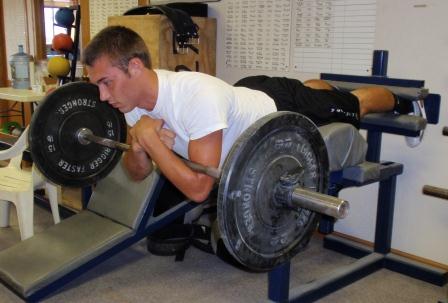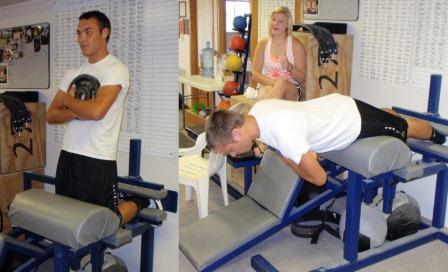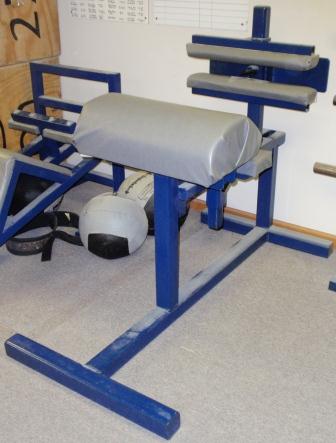Glute Ham Machine
by Al Myers
After my recent Daily News stories on the Roman Chair, I alluded to a similar (but much different) machine called the Glute Ham Machine (or also Glute Ham Developer, or the old name of Calf-Ham-Glute Machine). There is often confusion between the Roman Chair and the GH Machine, and I have heard lifters interchange the naming of these two distinct different apparatuses. First of all to me, they look NOTHING the same. And secondly, the muscles they work are completely different. The internet is loaded with information on GH Machines. There are many manufacturers of them – some better than others. The price tag for a good GH Machine runs from around $300 to over $1000. (there’s another difference – Roman Chairs are MUCH CHEAPER!). Most commercial gyms have a GH Machine, and the new age fitness crowd loves them. They are very popular with powerlifters and Olympic lifters as well. Dave Tate and Louie Simmons of Westside Barbell have done their part in promoting the GH Machine, embracing the many strength benefits the GH Machine offers.
As I said, the GH Machine works entirely different muscles than the Roman Chair. The Roman Chair primarily focuses on the abdominal muscles and the lower back, whereas the GH Machine focuses on the “posterior chain” muscles, ie the calves, hamstrings, and gluteal muscles. I really feel the hamstrings are the most undertrained muscle in most strength athletes training program. Competitive lifters place most of their training emphasis on the front quads (in form of squats) and neglect the ever important opposing hamstring muscles. In my early days of training I thought just doing a few high rep sets of leg curls at the end of my leg workout would suffice, but I learned the hard lesson with suffering a few hamstring muscle tears as a result of heavy deadlifts which proved to me that my hamstrings where indeed not trained adequately, and lagged in opposing strength. The hamstring muscles are a fast twitch muscle and needs to be trained with low reps, not high reps. Plus leg curls neglect the upper hamstrings which serve as a primary hip extensor. Louie Simmons knew this before anyone else, and that is why his “secret training programs” always included hamstring exercises like the GH Raises (as well as other things like Reverse Hyper exercises and weighted drags) to strengthen this typical “weak spot” in competitive lifters. The most common exercise done on a GH Machine is the Glute Ham Raise. I don’t have enough time in this story to describe how to do this exercise – just do an internet search and you will find TONS of descriptions on how to do this exercise as well as YouTube Videos demonstrating the GH Raise.

Bryce performs a Back Extension on the Glute Ham Machine. The Back Extension is an Official USAWA Lift.
There is one detail in a good GH Machine that needs mentioned. It should contain a knee pad that keeps the knees from “dropping” at the top end of the GH Raise. I have seen several commercial GH machines that don’t have this on them. Also make sure the GH Machine adjusts adequately so each lifter can get the right settings to allow for a GH Raise to be done correctly. Another very important distinction between a GH Machine and a Hyperextension Machine is that the “pivot” should be at the knees for a GH Raise, instead of the waist as when using a Hyperextension Machine. The body should remain straight from the knees up when performing a GH Raise. My GH Machine can adjust so it can also be used to do Back Hyperextensions. The Back Extension is an Official USAWA lift, but this lift has not been contested very often. It is a tremendous lower back exercise. The main difference between a GH Raise and a Back Extension is that you bend at the waist when performing Back Extensions, and the stress of the exercise is on the lower back.
GH Raises are a difficult exercise for heavier lifters who carry alot of weight in their upper body. I use my harness “walker” as a safety device in front of me when I do GH Raises. I do this so if I have problems on my last reps, I can push off the walker with my arms to finish the rep. GH Raises are one of my THREE FAVORITE hamstring exercises (and leg curls is not on my list!). You will feel the entire range of the hamstring muscle engaged (from the knees to the hips) with GH Raises, and afterwards you will feel the effects of your training in your ENTIRE hamstring. I also want to mention that GH Raises are a great exercise for young lifters who want to increase their vertical leap. The muscles of the hamstrings and calves are the biggest players in leaping ability, and this exercise focuses intently on these important leaping muscles. I don’t normally use added resistance when doing GH Raises, but it can be done easily with holding a plate on the chest. I feel the best rep ranges are between 5 and 8 repetitions with the GH Raise. If you have access to a GH Machine, give this exercise a try!

